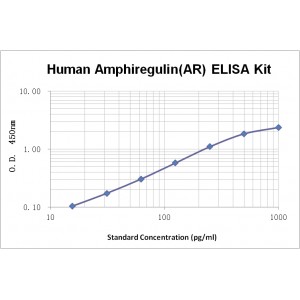More info
Assay Range | 15.6--1000 pg/mL |
Sensitivity | 10.0 pg/mL |
Specificity | No cross-reaction with other related substances detected |
Size | 96T |
Storage | Store at 2 - 8ºC. Keep reconstituted standard and detection Ab at -20 ºC |
Assay Principle | Sandwich ELISA |
Sample Volume | 100 µL final volume, dilution factor varies on samples |
Sample Type | serum, plasma or cell culture supernatant |
Detection Method | Chromogenic |
Kit Components
1. Recombinant Human Amphiregulin standard: 2 vials
2. One 96-well plate coated with Human Amphiregulin Ab
3. Sample diluent buffer: 12 mL - 1
4. Detection antibody: 130 µL, dilution 1:100
5. Streptavidin-HRP: 130 µL, dilution 1:100
6. Antibody diluent buffer: 12 mL x1
7. Streptavidin-HRP diluent buffer: 12 mL x1
8. TMB developing agent: 10 mL x1
9. Stop solution: 10 mL x1
10. Washing solution (20x): 25 mL x1
Background
Amphiregulin (AR or AREG), also known as Schwannoma-derived growth factor (SDGF) or Colorectum cell-derived growth factor (CRDGF), is a member of the epidermal growth factor family which also includes TGF-α, HB-EGF, Betacellulin (BTC), Epiregulin, and the Neuregulins 1 through 4. All EGF family members are type I transmembrane precursors and contain one or more EGF-like domains in their extracellular region. The full-length Amphiregulin is a 252 amino acid (aa) transmembrane protein composed of an 80 aa N-terminal propeptide, a heparin-binding domain, one EGF-like domain, a 23 aa transmembrane segment, and a 31 aa cytoplasmic domain. Multiple forms of native Amphiregulin containing either 78 or 84 aa and both N and O-linked oligosaccharides have been found. Soluble Amphiregulin is produced in response to ATP stimulation of dendritic cells and in response to CXCL12 stimulation of prostate epithelial cells.
Amphiregulin exerts autocrine and paracrine activities through EGF R and ErbB2. Its interaction with heparan sulfate proteoglycans enhances receptor activation and biological effects. Amphiregulin functions as a mitogen for many different cells such as, astrocytes, Schwann cells and fibroblasts. It plays an important role in branching morphogenesis of the lung and mammary gland, PGE2-induced regeneration of the intestinal epithelium, and suppression of Fas-mediated liver damage. In addition, Amphiregulin promotes inflammatory cytokine production and the clearance of nematode infections. In cancer, Amphiregulin is upregulated by tumor-associated dendritic cells. It promotes tumor progression by increasing proliferation, invasion, and angiogenesis.


